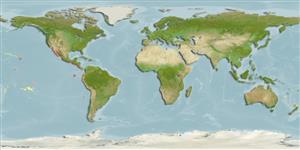Common names from other countries
分類 / Names
俗名 | 同種異名 | Catalog of Fishes(屬, 種) | ITIS | CoL | WoRMS | Cloffa
Teleostei >
Ophidiiformes (Cusk eels)
鼬鳚目 (Cusk eels) >
Bythitidae (Livebearing brotulas)
深蛇鳚科 (Livebearing brotulas)
Etymology: Grammonus: Greek, gramma = signal, mark + Greek, onos = hake.
Environment: milieu / climate zone / depth range / distribution range
生態學
海洋 礁區魚類; 深度上下限 6 - 18 m (Ref. 36488). 亞熱帶的
Eastern Pacific: San Clemente Island in south California, USA to Panama and the Galapagos Islands.
東太平洋: 在美國加州南方部到巴拿馬與加拉巴哥群島中的桑河 Clemente 島。
大小 / 重量 / 年齡
Maturity: Lm ? range ? - ? cm
Max length : 20.3 cm TL 雄魚/尚未辨別雌雄; (Ref. 4930)
背棘 (總數) : 0; 背的軟條 (總數) : 95 - 115; 臀棘: 0; 臀鰭軟條: 75 - 91; 脊椎骨: 60 - 63. Branchiostegal rays: 8 (Ref. 36488).
鰓條骨: 8.(參考文獻 36488)
Uncommon species (Ref. 34024). Inhabits rocky areas of shallow waters (Ref. 2850). Hides in dark caverns and crevices during the day, active at night (Ref. 2850). Gives birth to live young (Ref. 28023).
稀有的種.(參考文獻 34024) 棲息於淺水域的岩石區。 (參考文獻 2850) 躲在深色的巨穴與裂隙中在白天期間, 活躍的在晚上.(參考文獻 2850) 對活的幼魚生產。 (參考文獻 28023)
Life cycle and mating behavior
Maturities | 繁殖 | Spawnings | Egg(s) | Fecundities | 仔魚
Ovoviviparous (Ref. 36488).東太平洋: 在美國加州南方部到巴拿馬與加拉巴哥群島中的桑河 Clemente 島。
Nielsen, J.G., D.M. Cohen, D.F. Markle and C.R. Robins, 1999. Ophidiiform fishes of the world (Order Ophidiiformes). An annotated and illustrated catalogue of pearlfishes, cusk-eels, brotulas and other ophidiiform fishes known to date. FAO Fish. Synop. 125(18):178p. Rome: FAO. (Ref. 34024)
CITES (Ref. 128078)
Not Evaluated
人類使用
漁業: 沒有興趣
工具
特別的報告
下載 XML
網路資源
Estimates based on models
Preferred temperature (Ref.
115969): 21.3 - 29.1, mean 26.7 (based on 204 cells).
Phylogenetic diversity index (Ref.
82804): PD
50 = 0.5005 [Uniqueness, from 0.5 = low to 2.0 = high].
Bayesian length-weight: a=0.00457 (0.00179 - 0.01169), b=3.10 (2.87 - 3.33), in cm Total Length, based on LWR estimates for this (Sub)family-body shape (Ref.
93245).
營養階層 (Ref.
69278): 3.5 ±0.50 se; based on food items.
回復力 (Ref.
120179): 高度, 族群倍增時間少於 15個月 (Preliminary K or Fecundity.).
Fishing Vulnerability (Ref.
59153): Low vulnerability (10 of 100).
